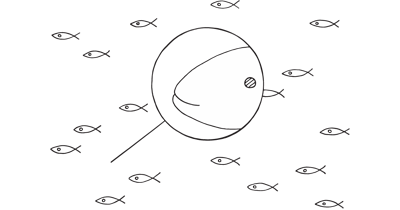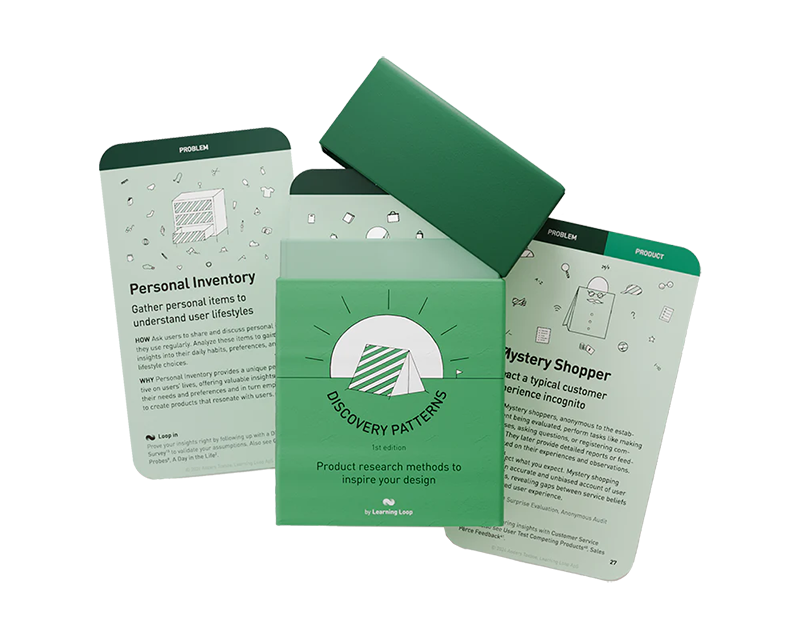Idea Validation: Problem, Market demand, Product, Willingness to pay
Competitive Analysis
Identify market opportunities and threats

How: Conduct in-depth analysis of competitors' strategies, products, and market success. Focus on how they address similar problems and needs, and their viability and desirability in the market. Identify gaps in their solutions to build your unique value proposition.
Why: Competitive analysis validates market needs and price willingness by evaluating existing solutions. It identifies market gaps and guides product development for better market fit.
Understanding how your product compares to others in the market is critical. Competitive Analysis is used to systematically assess and compare products to inform design decisions, surface usability insights, and identify opportunities for differentiation. This approach can reveal both industry benchmarks and user expectations, helping teams prioritize improvements and innovate with purpose.
Competitive Analysis in UX involves evaluating competitors’ products or services to identify strengths, weaknesses, usability trends, and potential opportunities. It extends beyond aesthetics or surface features, aiming to understand how users interact with competing systems and what mental models they bring to those interactions. Often, it includes both expert evaluations and user testing across multiple platforms, allowing for side-by-side comparisons that go deeper than market positioning.
Competitive Analysis is particularly useful during the early stages of a new project or product redesign. It can validate assumptions, shape early design ideas, and ensure that you don’t reinvent the wheel. But it’s also valuable throughout the product lifecycle as a tool to track shifts in industry standards and competitor offerings. Ongoing analysis ensures a product stays relevant and competitive.
Conducting this analysis helps teams:
- Benchmark usability and feature expectations.
- Uncover competitor pitfalls to avoid.
- Surface design conventions and patterns users are already familiar with.
- Explore differentiation opportunities.
- Justify design decisions to stakeholders with evidence.
Selecting competitors and setting ccope
Choosing the right competitors is a key first step. Direct competitors offer similar products to the same audience, while indirect competitors may serve the same need in a different way. A typical evaluation includes 2 to 5 products, balancing breadth with depth. You might also include comparative examples—products not in your domain but with features or flows relevant to your project.
Scope-setting is equally important. Focus the analysis on key features or flows, such as onboarding, task completion, or search functionality. Tailor this based on your business goals, user needs, or known friction points.
There are two main methods:
- Competitive reviews. UX researchers or designers conduct expert evaluations of competitors using heuristics, task walkthroughs, or design pattern analysis. This can be broad (full product review) or narrow (focused on a single task).
- Competitive usability testing. Real users perform similar tasks across different products. These sessions are usually structured so that the task order is randomized to reduce bias. Post-task reflections and preferences provide insight into user satisfaction and perceived usability.
Both methods can be paired with tools such as journey mapping, heatmaps, or task success metrics to support analysis.
To enrich your competitive analysis, consider adding:
- Heuristic evaluation of competitors.
- Hands-on testing of the products.
- Reading app reviews (e.g., from app stores or Trustpilot).
- User journey mapping across products.
- Feature comparison tables to identify functional gaps.
These tactics can deepen insights without requiring full usability testing.
Documenting and presenting findings
There’s no single format for presenting findings, but clarity and actionability are key. Use comparison matrices, annotated screenshots, or slides highlighting strengths and weaknesses. Include a summary of insights and design implications. A well-organized artifact can support strategic decisions and communicate value to stakeholders.
Example criteria to assess:
- Sign-up flow
- Task discoverability and speed
- Mobile vs desktop experience
- Help and support visibility
- Visual hierarchy and accessibility
Getting it right
Before beginning a competitive analysis, it is important to be clear about what you are trying to learn or solve. Setting concrete goals aligned with business or design challenges ensures that the analysis remains focused and useful. Trying to examine everything at once often results in surface-level insights that lack strategic value.
The scope of analysis should be intentionally limited. Instead of attempting to review entire applications or end-to-end flows, it’s often more effective to concentrate on the most impactful or problematic parts of a product. This could be a specific task, like onboarding or checkout, or a feature that your team is currently redesigning. Limiting scope allows deeper evaluation and better usability insights.
It’s also important to include your own product in the mix when conducting a competitive evaluation. Seeing your product alongside others brings perspective, clarifies positioning, and encourages honest reflection. This can spark internal alignment around priorities and drive productive critique.
As you evaluate competitors, remember that the goal is not to copy features or mimic user interfaces. Instead, look for inspiration, patterns, and principles that can inform your own approach. Understand what competitors are solving well and where they fall short, and then consider how your product can address user needs in ways that are both relevant and differentiated.
Measuring success
The value of a competitive analysis is ultimately tied to how effectively its findings inform product strategy and design direction. To measure its success, it’s important to look at both the quality of insights produced and their practical application.
One tangible output is a clear market rank—a snapshot of where your product stands in relation to its direct and indirect competitors. This helps internal teams understand whether your experience is leading, lagging, or aligning with the current market standard. This position isn’t static; it provides a benchmark for tracking progress over time.
Another key deliverable is a feature benchmark, a comparative view of what features exist across the competitive landscape, how they are implemented, and how users respond to them. This helps teams avoid redundant solutions and spot usability gaps or opportunities to streamline flows. Benchmarks should include not only what features are present but how usable and discoverable they are across interfaces.
Competitive analysis also surfaces market opportunities—areas where user needs are under-addressed or underserved. These opportunities may reveal themselves through user pain points in competitor products, inconsistencies in functionality, or emerging design patterns in tangential industries. When well captured and communicated, these insights can shape product roadmaps, guide innovation, and support prioritization.
Deliverables may take the form of comparison tables, visual reports, slide decks, annotated screenshots, or journey maps. The format should align with your team’s workflow and stakeholder preferences, ensuring findings are not only insightful but also actionable.
Context matters: why copying competitors can backfire
While competitive analysis is a valuable tool for identifying design trends and understanding market expectations, it’s critical not to fall into the trap of copying competitor features or layouts without considering the underlying context. Features that appear successful in one product may be deeply tied to that product’s history, technical architecture, or unique audience needs. Without understanding these factors, replicating such elements can result in designs that feel out of place or function poorly within your own product.
Many design decisions are the product of legacy systems, prior constraints, or business model dependencies. What works well for a long-established competitor may be rooted in compromises that don’t apply—or shouldn’t apply—to your own product. Copying these decisions can introduce unnecessary complexity or create misalignment with your users’ goals and expectations.
Instead, competitive insights should be used to inform, not dictate. As you evaluate how others solve similar problems, reflect on how those solutions might—or might not—translate for your users. Consider how people interact with your product today, what pain points they experience, and what expectations they bring based on their prior usage. By grounding design decisions in the real-world context of your product and its users, you ensure that inspiration from competitors leads to improvements that are not only functional but also meaningful.
Popular tools
The tools below will help you with the Competitive Analysis play.
-
Crayon
A competitive intelligence platform that tracks competitors' website changes, marketing strategies, and feature updates to support broader UX and market analysis.
-
Similarweb
Used to understand competitor traffic sources, audience segments, and engagement metrics. Offers a high-level view of how competitor platforms are performing.
-
AppFollow
Aggregates competitor app reviews and ratings across stores. Helpful for benchmarking usability pain points and feature requests based on real user feedback.
Real life Competitive Analysis examples
Samsung
Samsung conducts competitive analysis to understand how competitors address similar market needs, informing their strategies for product differentiation and innovation.
Intel
Intel’s competitive analysis includes assessing the viability and desirability of competitor products in the semiconductor industry, guiding its strategic planning.
A collection of clever product discovery methods that help you get to the bottom of customer needs and coining the right problem before building solutions. They are regularly used by product builders at companies like Google, Facebook, Dropbox, and Amazon.
Get your deck!Related plays
- Competitive Usability Evaluations by Nielsen Norman Group at Nielsen Norman Group
- A Guide to Competitive Analysis for UX Design by Jill DaSilva at Medium (Design Bootcamp)
- Competitive Analysis for UX – Top 6 Research Methods by UXPin Team at UXPin
